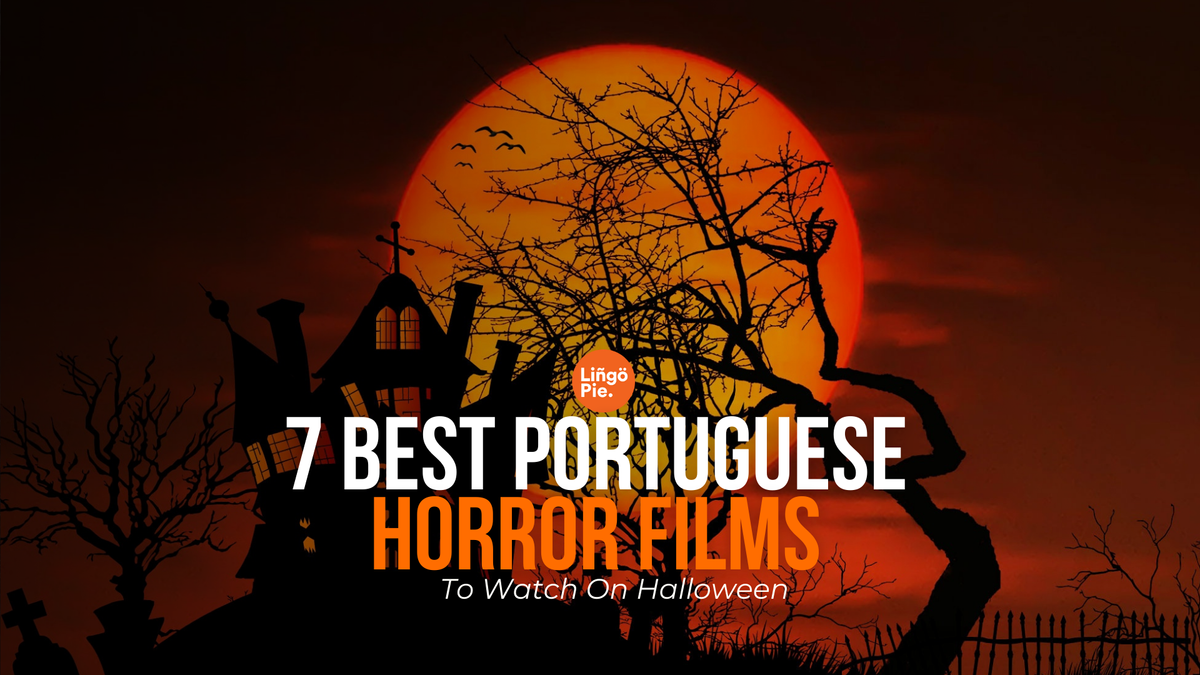Horror in the US has started to feel predictable. The same jump scares and recycled tropes make it hard to find something that really unsettles. Portuguese horror offers a welcome change, with ghost stories that linger and psychological thrillers that cut deeper.
It also gives you the chance to improve your Portuguese. Hearing the language in moments of tension makes new words and phrases easier to remember, so you get both the scares and a little language practice along the way. So in this post, I’ll share 7 Portuguese horror films worth adding to your Halloween lineup if you want to get scared and learn at the same time!
- Is Portuguese Hard To Learn? Honest Opinion + Tips
- How To Learn Portuguese Fast? [Best Guide]
- Hello In Brazilian Portuguese: 13+ Easy Greetings To Use

Portuguese Halloween Vocabulary
Watching horror films in Portuguese is a good way to train your ear. The more familiar you are with common spooky words, the easier it becomes to follow the story and enjoy the atmosphere. Here are fifteen essentials to listen for during your next movie night:
- o fantasma – ghost
- a bruxa – witch
- o vampiro – vampire
- o lobisomem – werewolf
- o monstro – monster
- o esqueleto – skeleton
- o zumbi – zombie
- a caveira – skull
- o cemitério – cemetery
- o caixão – coffin
- o feitiço – spell
- o sangue – blood
- o grito – scream
- o medo – fear
- assustador – scary
Best Portuguese Horror Films
Here are the best Portuguese horror movies along with their synopses and key themes:
1. Os Canibais (The Cannibals)
Manoel de Oliveira’s 1988 film starts as a high-society wedding, where every line is sung like an opera. At first, it feels like a costume drama about romance and honor, but the story slowly twists into a surreal nightmare of cannibalism and bizarre rituals. By the end, what looked like a refined love story becomes a shocking parody of aristocratic life.
For learners, this film is unusual because of its operatic dialogue. The characters use formal, almost archaic Portuguese, which is not how people speak today but gives insight into older, literary forms of the language. The singing makes pronunciation and rhythm stand out, so you can train your ear even if the vocabulary feels advanced.
2. Coisa Ruim (Bad Blood)

This 2006 film follows a professor who moves his family to a rural village after inheriting a house. The locals avoid talking directly, but their silence and superstitions hint at something dark. When strange events start happening in the house, the family begins to believe they have inherited more than just property — perhaps a curse that no one dares name.
For learners, Coisa Ruim is valuable because it contrasts educated, city speech with rural Portuguese. You will hear casual dialogue, religious references, and regional idioms, which helps you understand how the language shifts between settings. The mix of modern and traditional vocabulary gives a fuller picture of European Portuguese.
3. A Noiva (The Bride)
On her wedding day, a young bride is brought into her new husband’s family home for a strange ceremony. At first, it looks like a cultural ritual, but as the night goes on the atmosphere grows suffocating. The bride slowly realizes she is part of something far darker than a celebration, and escaping may not be possible.
For learners, the film is easier to follow because it uses modern, conversational Portuguese. The domestic setting means you hear everyday words about family, homes, and relationships. At the same time, the tense atmosphere introduces emotional language around fear and suspicion that makes the dialogue more memorable.
4. O Barão (The Baron)

Based on a 1942 novella, this black-and-white film follows a school inspector who visits a remote region. There he meets the Baron, a decadent figure who insists on his authority. The inspector soon finds himself drawn into the Baron’s world, where rules and reality no longer follow logic. The film creates a gothic, dreamlike space where you can never tell what is real.
For learners, the dialogue feels theatrical and stylized. It uses vocabulary closer to literature than daily conversation, making it best for advanced students. Watching it helps you hear how Portuguese can be used in a more formal, abstract way, which is useful for understanding literature and older cultural references.
5. Isolados
A psychiatrist, Lauro, takes his partner Renata to a remote mountain house to rest. They believe they have found peace, but news spreads of a serial killer couple in the area. When the killers come closer, the couple realize the isolation that was meant to protect them now leaves them trapped.
Because it is Brazilian, the film is filled with natural, conversational Portuguese. Learners can pick up everyday phrases used in relationships and travel, while also noticing regional expressions that set Brazilian speech apart from European Portuguese. The tense setting adds useful survival and emotional vocabulary.
6. Mal Nosso (Our Evil)

A father with visions of the supernatural knows his daughter is in danger from a demonic force. To save her, he hires a hitman, but the story moves beyond crime into spiritual horror. Each turn deepens the sense of dread and questions how far a parent can go to protect their child.
For learners, this film is useful because it mixes different registers of Brazilian Portuguese. Some scenes use casual, street-level dialogue, while others turn toward spiritual and philosophical vocabulary. It gives you practice with both everyday communication and more abstract, emotional language.
7. A Floresta das Almas Perdidas (The Forest of Lost Souls)
In Portugal’s most infamous forest, known as a suicide spot, two strangers meet by chance. At first, their conversation seems sympathetic, but one of them hides darker intentions. What begins as a quiet, tragic encounter shifts into a psychological game of manipulation and violence.
The slow pace and minimal dialogue make it easier to follow for learners. The film introduces vocabulary around emotions, death, and nature, with plenty of pauses that give you time to process the Portuguese being spoken. It is a good entry point into European Portuguese for those still building confidence.
Where To Watch Portuguese Horror Films?
Portuguese horror films are a unique treasure in the world of cinema, blending local folklore with universal themes of fear and suspense. Here’s how you can dive into this exciting genre:
- Lingopie: If you want to turn horror movie night into a language lesson, Lingopie is the most learner-friendly choice. It offers Portuguese shows and films with interactive subtitles, so you can click on any word to see instant translations and save vocabulary.
- Netflix: A convenient option with a selection of Portuguese films. You might find titles like "Mal Nosso" and "A Floresta das Almas Perdidas."
- Amazon Prime Video: Occasionally offers Portuguese films. Availability varies by region, so it's worth checking the catalog.
- MUBI: Known for its curated collection of international films, MUBI sometimes features Portuguese horror films, especially those with critical acclaim.
- Filmin: A platform specializing in Iberian and Latin American cinema, Filmin is a great place to explore Portuguese films, including the horror genre.
Learn Portuguese With Horror Films
In this article, we've taken a spooky journey through Portuguese horror movies, looking at some really interesting films and what makes them special. We've also talked about where you can watch these movies, like on Netflix.
If you want to learn more about Portuguese movies and even pick up some of the language, Lingopie is a great website to try. Lingopie shows movies from around the world and helps you learn new languages as you watch.
So, why not start exploring these creepy movies today while learning a foreign language? Sign up for Lingopie, check out more articles on our blog, and enjoy all the scary stories and cool lessons Portuguese horror movies have to offer.









![How to Learn Portuguese Through League of Legends [Guide]](/blog/content/images/size/w300/2025/11/League-of-Legends---Worlds-2025--1-.jpg)